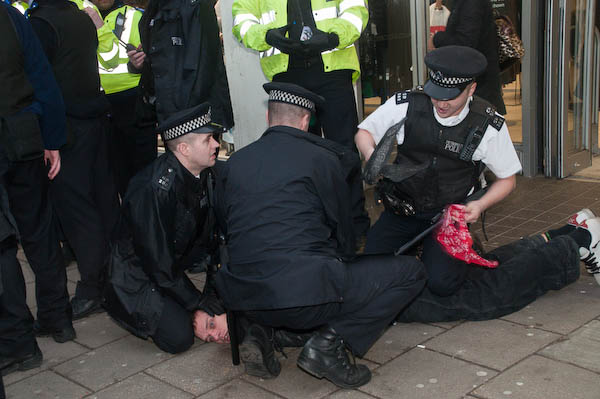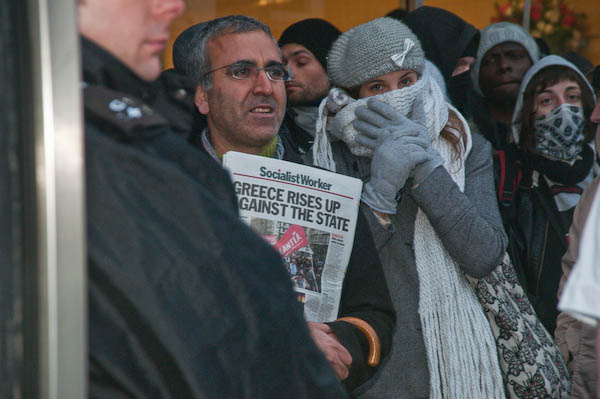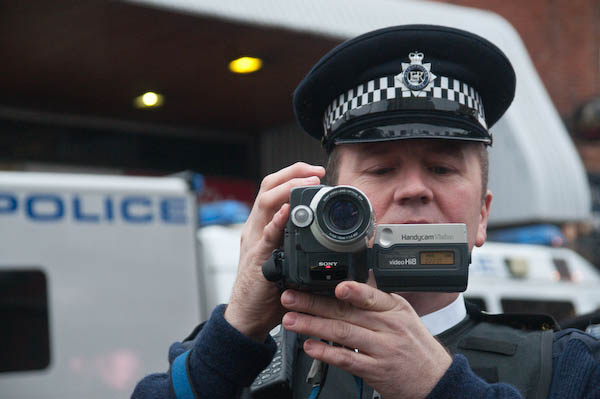You can’t really compare the events in London with those in Greece, but if the Met haven’t yet started shooting harmless teenagers for being on the streets, they do seem to be stepping up the pressure against anarchists and other demonstrators, as well as journalists.
Over the last week or so we’ve also seen an inquest verdict on the shooting of an innocent man, in which the jury were clearly prevented from reaching the verdict of unlawful killing they felt deserved, making clear that they didn’t believe the evidence given by several of the police concerned. (And it’s not clear if the shoot-to-kill policy they were following was legal – it was certainly introduced without proper debate.) We’ve seen a photographer, Jess Hurd, covering a travellers’ wedding for The Guardian detained by police for forty-five minutes in London’s docklands by police misusing anti-terrorist legislation, (you can see the wedding pictures here), photographers covering a demonstration outside the Greek Embassy assaulted, (it happened again later in the week) and many other smaller incidents in which the press is harassed and obstructed in covering protests.
So I expected there might be some problems with the police last Sunday when I went to photograph a march by Anarchists along with Greek students and workers in protest against the events in Greece. Rather than at the embassy, it was being held in North London in an area where there is a sizeable Greek population.

Police arrest and unmask a protester they alleged to have assaulted an officer
What I didn’t expect was that the police would decide to use the powers they have under the 1994 Public Order Act to force people to remove face coverings where the officer concerned is convinced they are worn wholly or mainly to conceal identity – and an Inspector or higher rank has issued an authorisation for such actions in that particular place (and time.)
It is of course arguable whether masks are worn at such events to conceal identities rather than as some kind of ‘uniform’ or even a fashion statement or just to keep warm. Few of those taking part in demonstrations have any real need to conceal their identity, and masks are seldom a truly efficient way of doing so – most of their wearers remain easily identifiable and many remove their masks at times during events.
What is clear than an attempt to get all those taking part to remove masks was doomed to failure and would considerably raise tempers at the event. Those making the decision clearly did not want the march to go ahead but wanted to create a flash-point that would lead to a confrontation between police and anarchists.

Demonstrators in the kettle.
Police complained I was too close when I took this picture – though a gap between three separated lines of police.
It was a confrontation set up to show who was boss. And although the police were rather slow in bringing up reinforcements after they only managed to “kettle” a small fraction of the anarchists (along with rather more of the Greek students and workers) they were clearly in command.

I’m starring in the film for the Police Xmas Party again
You can read a more detailed account of the events in Dalston on My London Diary, where the story is also told in pictures. My job was occasionally made difficult by the police, particularly in their insistence on keeping a clear zone around the kettle and I did get pushed around a few times when the crowd spilled over into the street and colleagues took a few amusing pictures of me arguing with police about the rights of a free press, but I saw none of the assaults and attempts to grab cameras that had marred the events outside the Greek Embassy in the previous week.